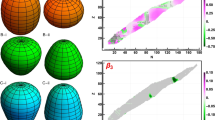Abstract:
We propose a direct method of detection of the nuclear anapole moment. It is based on the existence of a linear Stark shift for alkali atoms in their ground state perturbed by a quadrupolar interaction of uniaxial symmetry around a direction and a magnetic field. This shift is characterized by the T-even pseudoscalar ( . )(∧ . )/B 2. It involves on the one hand the anisotropy of the hyperfine interaction induced by the quadrupolar interaction and, on the other, the static electric dipole moment arising from electroweak interactions inside the nucleus. The case of ground state Cs atoms trapped in a uniaxial (hcp) phase of solid 4He is examined. From an explicit evaluation of both the hyperfine structure anisotropy and the static dipole deduced from recent empirical data about the Cs nuclear anapole moment, we predict the Stark shift. It is three times the experimental upper bound to be set on the T-odd Stark shift of free Cs atoms in order to improve the present limit on the electron EDM.
Similar content being viewed by others
Author information
Authors and Affiliations
Additional information
Received 20 December 2000
Rights and permissions
About this article
Cite this article
Bouchiat, M., Bouchiat, C. An atomic linear Stark shift violating P but not T arising from the electroweak nuclear anapole moment. Eur. Phys. J. D 15, 5–18 (2001). https://doi.org/10.1007/s100530170177
Issue Date:
DOI: https://doi.org/10.1007/s100530170177



